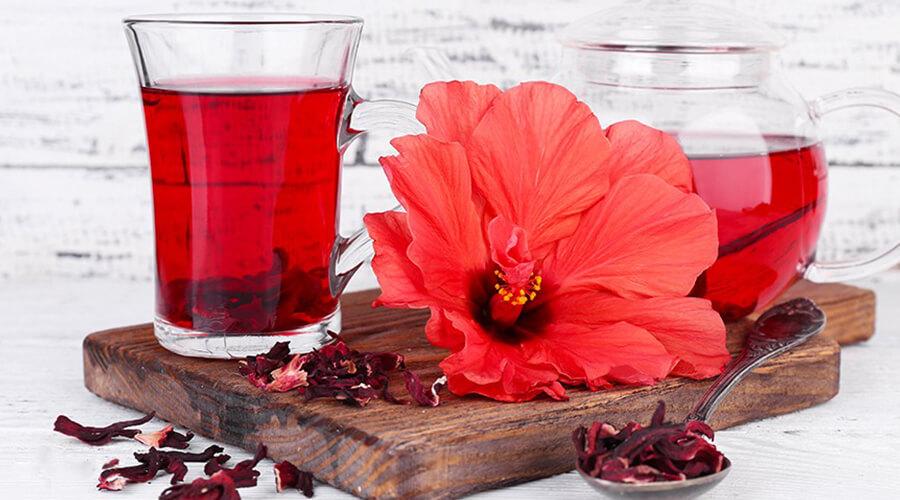
We have recently been introduced to hibiscus, this beautiful herb.
As well as being a beautiful flower, hibiscus is a cure for many ailments.
It is mainly consumed as tea.
Hibiscus tea helps lower blood pressure. It prevents the development of tumours, as the compounds it contains have anti-inflammatory properties and also prevent the spread of an existing tumour. It also has antibacterial properties and has a calming effect, which is why it can be used to treat anxiety, stress and colds. Hibiscus tea helps digestion. Able to help with urinary problems. It also has diuretic properties and is recommended for constipation. It is also very good for weight loss and supports stomach and intestinal function. Regular consumption can prevent rectal cancer. It has antidepressant effects due to the active substances contained in hibiscus.
The effects of hibiscus tea do not stop there, as it has the ability to keep LDL, or ‘bad’ cholesterol levels low thanks to its antioxidant properties. This protects against heart disease and damage to blood vessels. It is also a great liver protector because of its antioxidant properties. Liver problems may be worth trying hibiscus tea.
Contains vitamin C which strengthens the immune system.
It can also be used for fever as it has the ability to lower the body temperature. It reduces appetite, speeds up circulation and can also be used to relieve coughing. Can also be used in beauty care as it has anti-ageing properties. For those taking contraceptives, hibiscus tea is not recommended. Consuming it will reduce fertility. In case of childbearing, hibiscus tea should be avoided. For people suffering from low blood pressure, hibiscus tea is not recommended as it has a strong hypotensive effect. In very rare cases, hibiscus tea can even cause hallucinations, which can make a person feel drunk or dizzy.
Egyptian hibiscus tea is a traditional medicinal drink. Interestingly, the hibiscus is the bird of Ibis, as it is known in Egyptian mythology. In Egypt, the consumption of hibiscus tea is commonplace and is used in almost every drink. It is also a favourite drink in cafés and at social gatherings.
Effect of hibiscus tea on hair
Tea made from hibiscus flower petals is rich in antioxidants, vitamin C and other nutrients that can help improve hair condition.
Improving blood circulation: a clear benefit of hibiscus flower tea is that it can help improve blood circulation, which can contribute to scalp health and nourish hair follicles.
Antioxidants: antioxidants found in hibiscus can help fight harmful free radicals that can damage hair and scalp.
Vitamin C content: the vitamin C in hibiscus can help to promote collagen production, which is important for healthy hair and skin.
Hydration: Hibiscus tea can help hydrate the body, and adequate hydration is important for maintaining healthy hair.
Anti-inflammatory: hibiscus tea also has anti-inflammatory properties, which can help reduce inflammation of the scalp and support healthy hair growth.
How to make hibiscus tea:
Making hibiscus tea is not a difficult and long process. In just a few minutes you can start enjoying its benefits. It is worth knowing that hibiscus flower tea is the most potent, so you should only make herbal tea from its flowers. Making hibiscus flower tea is therefore the traditional hibiscus tea, as the flower is the medicinal part. Boil 5 dl of water and add 3 tablespoons of dried hibiscus flowers. When the dark red juice has run out, let it cool a little. Then strain the soaked petals.
You will get a thicker extract, which you pour over 1 litre of cold water! Pour into a jug or jar and refrigerate! It can be eaten without flavouring, but if you like, you can sweeten it with honey. The brew has a sour taste, similar to sour cherries. It’s a great thirst quencher and a great cooler. But it can also be eaten warm.
The daily dose of hibiscus tea varies depending on the problem. For those with hypertension, 3 cups of hibiscus tea per day is recommended. However, it is important to consult with your doctor before doing so. For diabetics, 2 cups of tea per day is recommended, but should only be taken as a course of treatment for 1 month. Steeping hibiscus tea is also very effective. Because of its high vitamin C content, steeping is as useful as boiling. After steeping for about 20 minutes, you get a fairly concentrated drink, which you can then dilute.
Making Egyptian hibiscus tea the traditional way
Egyptian hibiscus tea, or “karkadé” (كركديه) as it is locally known, is a popular drink in Egypt and other Middle Eastern countries.
Ingredients:
Dried hibiscus inflorescences (about 2-3 tablespoons)
Water (about 4-5 cups)
Sugar or sweetener to taste (optional)
(2 tablespoons of sugar (approx. 2 teaspoons of sugar, water, sugar, salt, sugar, etc.) (optional)
The steps of preparation:
Boil water: put water in a pot and bring to the boil. For a traditional preparation, you can use about 4-5 cups of water.
When the water has boiled, remove from the heat, remove from the hob and add about 2-3 tablespoons of dried hibiscus inflorescences. Allow the inflorescence to float on the surface of the water.
Cover the pot with a lid and let stand for 10-15 minutes. During this time, the hibiscus inflorescence will give the drink a beautiful red colour and intense flavour.
Straining and sweetening: once the steeping is complete, strain the drink through a sieve or spoon the inflorescence into another container. The traditionally made drink is usually quite strongly acidic.
Chilling and serving: allow the tea to cool, then refrigerate it to enjoy cold. When serving, garnish with ice cubes and fresh mint leaves or lemon wedges.



